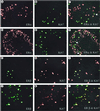Estrogen receptors and proliferation markers in primary and recurrent breast cancer
- PMID: 11734621
- PMCID: PMC65006
- DOI: 10.1073/pnas.211556298
Estrogen receptors and proliferation markers in primary and recurrent breast cancer
Abstract
To elucidate the clinical importance of estrogen receptor (ER) beta in breast cancer, 29 archival primary breast cancer specimens, six locally recurrent cancers, and five benign mammary tumors were examined histochemically for ERalpha, ERbeta and the proliferation markers Ki67 and cyclin A. In benign tumors, most epithelial cells contained ERbeta, but ERalpha was rare. In primary cancers, both ERalpha and ERbeta occurred in epithelial cells, the presence of ERbeta being associated with elevated expression of Ki67 and cyclin A, and ERalpha with decreased levels. Thus, the highest content of proliferation markers was seen in primary cancers that were ERalpha(-) ERbeta(+). Most Ki67-containing cells coexpressed ERbeta, but few showed ERalpha. In locally recurring cancers, ERalpha, ERbeta, and Ki67 were more highly expressed than in the corresponding primary tumors, and many cells containing ERbeta, but few with ERalpha, expressed Ki67. Surprisingly, ERbeta, but not ERalpha, was seen in the stromal cells of both primary and recurrent cancers. Because the response of breast cancers to tamoxifen therapy is correlated with the presence of ERalpha, cancer cells that lack ERalpha but contain ERbeta and proliferation markers represent a novel population of apparently proliferating cells that probably are not targeted by the current antiestrogens. Thus, appropriate ERbeta-specific ligands, perhaps in combination with tamoxifen, may be useful in improving the treatment of breast cancers.
Figures



References
-
- Warner M, Nilsson S, Gustafsson J-Å. Curr Opin Obstet Gynecol. 1999;11:249–254. - PubMed
-
- Simpson E R. Mol Cell Endocrinol. 1998;145:55–59. - PubMed
-
- Ogawa S, Washburn T F, Taylor J, Lubahn D B, Korach K S, Pfaff D W. Endocrinology. 1998;139:5058–5069. - PubMed
-
- Wenger N K. Curr Opin Cardiol. 1999;14:292–297. - PubMed
Publication types
MeSH terms
Substances
LinkOut - more resources
Full Text Sources
Other Literature Sources
Medical

